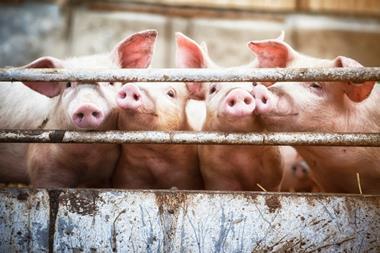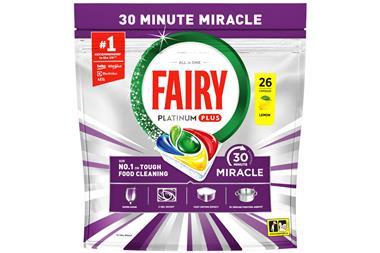Oh how things change. For the past few years we have used the publication of the Corporate Index to exhort the food and drink industry to grasp the nettle of growth and innovation and start to tackle the problem of the industry's reputation, earned during the late 1990s, for consistently disappointing investors.
More telco/dotcom/M&A-style razamatazz was the City's advice to the tired old food company looking to restore its faded veneer. However now with the Blodgetts and the Meekers confined to an extended and welcome retirement it is perhaps time to re-examine the food sector in a new and fresh light.
Why this new enthusiasm? A look at the markets is instructive.
Up to the peak of the telco/dotcom boom in February 2000, European telco stocks delivered a compound annual return to shareholders of around 60%-plus. In contrast, food companies languished at around the 13% level.
Then came the turnaround. Since February 2000, omitting this month's market trough, European telco stocks have delivered annual returns of minus 45%.
Food companies have delivered 22% positive returns and are deservedly back in vogue. No wonder that the food plants of the Midlands, the north and Scotland once again ring with the sound of the equity analysts' footsteps.
This year's Corporate Index provides a useful snapshot of what is going on, as well as some insight into why the investment community should, perhaps, not have been so pessimistic in the first place.Immediately striking are the high and sustained returns on capital being generated up to nearly 23% in 2001.
While the return on capital measure always suffers from distortions (principally the impact of intangibles and goodwill, which we exclude) we can be comfortable that there is no room for Enron/Worldcom-style funny money here. This is, more or less, real economic profit being earned from real kickable' assets by substantial firms with a real future. Hallelujah!
We have all been told that the industry is mature, with food taking a declining share of the consumer's wallet in most European countries. However maturity, as Joan Collins will tell you, can be a virtue. Modest top-line growth is obscuring the fact that there is still massive room for further industry consolidation.
Majors such as Cadbury Schweppes are achieving top line growth of 20%-plus on the back of targeted acquisitions in core businesses with significant synergy potential.
Likewise private equity firms such as Doughty Hanson and Hicks Muse are buying under-exploited assets such as RHM and UB at good prices and putting together sector-level consolidation strategies of their own.
The industry's net margin is holding steady at 8.5%. This is a substantial figure in absolute terms and gives the lie to the fact that food processing is a low margin' enterprise, particularly when combined with the relative stability and quality of earnings.
Several players usually those with strong branded positions deliver returns on turnover that a pharmaceutical company would envy. For example Wrigley has an operating margin of nearly 30% and Bestfoods (now owned by Unilever) one of nearly 25%.
Events in the US are more than ever reinforcing the old adage that profit' is a matter of opinion at best. The result will be a massive swing in investor sentiment towards cash-generative businesses and an increasing preoccupation with the rate at which accounting profit is being converted into cash.
Once again the food company can shine here. For example, Cadbury Schweppes converts more than 95% of its operating profit into free cash available to fund acquisitions or to redistribute to shareholders.
While the industry's performance is being looked at in a new light, we must temper our enthusiasm. Nothing has changed in the continuing battle against retailer pricing power, own label attrition and ongoing competitive erosion. New challenges such as the return of commodity price inflation and retailer pressure for factory gate pricing are now rearing their head.
Sentiment has changed more than the underlying commercial reality. However with that change comes an increased level of respect, dialogue and appetite to invest. Normal service has been resumed.
l How the index is compiled
Compiling and interpreting a financial index is a difficult and complex task, especially when the aim is to represent the whole industry. Setting aside the problems of having to depend on the published accounts at Companies House, there are difficulties in deciding which companies to include and which financial measures to use.
The objective of the OC&C Corporate Index is to provide a fair representation of the overall financial trends within the industry. While the performance of individual companies is undoubtedly interesting, OC&C urges those analysing individual companies to refer to the set of individual accounts in order to understand the accounting policies being used and the underlying reason for any performance trends.
The following criteria and definitions listed on the following page have been used in compiling this index. OC&C has attempted to include those major food manufacturers and processors who filed accounts and a representative sample of smaller companies. The resulting group encompasses a wide variety of food industry sectors from, for example, chicken processing to breakfast cereals. For large diversified food companies comprising a few major subsidiaries, such as Unilever, OC&C has listed, where possible, their major operating companies.
A number of companies listed in the index have activities outside mainstream food manufacturing and processing. Major firms which have recently been acquired have been retained as a separate listing when separate accounts are filed.
Owing to acquisitions, there is the possibility of double-counting when preparing the overall industry composite. Depending on the date of the acquisition and year-end of the acquirer, the latest set of financial accounts may include some of the acquired company's results.
Financial year-ends and speed of filing differ between companies. Rather than attempting to match up accounting periods, the two most recent years have been selected.
Caution, therefore, needs to be exercised in comparing companies whose returns and trends span different time periods. In the few cases where companies have changed their year ends, lengthening or shortening their financial year, the sales and profit values have been annualised.
l Definitions
Operating profit equals profit before interest payable and tax, but includes income from associated companies and investments where relevant. It excludes amortisation of goodwill and exceptional items relating to profit/loss on sale of fixed and intangible assets, reorganisation costs, losses on disposal of operations, cash received and release of provisions from discontinued operations. Where necessary, OC&C has used information given in the published accounts to adjust the stated figure for the operating profit to meet the above definitions.
Operating profit margin (%) equals operating profit divided by sales (including share of joint venture turnover where relevant).
Capital employed equals total assets (excluding intangibles) less current liabilities (excluding short-term borrowings). Inter-company balances described as "loans" are classified as borrowings.
Return on capital (%) equals operating profit divided by the average of the year-end and previous year-end capital employed. Where a relevant capital employed figure is not available, or is not comparable, the return on capital is indicated as "not applicable". The totals exclude data for such companies.
Historical cost accounting conventions have been used, unless only current cost accounts have been filed.
While reasonable care has been taken to ensure that stated facts are accurate and opinions fair, OC&C shall not be responsible for any errors or omissions.
©OC&C Strategy Consultants 2002
{{FEATURES }}
Close menu
- Home
- Retail & Wholesale
-
Products & Suppliers
- Back to parent navigation item
- Products & Suppliers
-
Product Categories:
- Back to parent navigation item
- Product Categories:
- Alcoholic drinks
- Bakery
- Cereals & breakfast
- Cheese
- Chicken & poultry
- Chocolate
- Confectionery
- Crisps, nuts & snacks
- Dairy
- Fish
- Fresh produce
- Frozen
- Household
- Meat
- Own Label
- Sauces & condiments
- Seasonal
- Soft drinks
- Vaping
- Vegan & plant-based
- World foods
- Suppliers
- People
- Reports & Data
-
Topics A-Z
- Back to parent navigation item
- Topics A-Z
-
Popular topics:
- Back to parent navigation item
- Popular topics:
- Cost of living crisis
- Crime
- Deposit Return Schemes
- Finance
- Government & Regulation
- Health
- Inflation
- Loyalty
- Marketing
- Mergers & Acquisitions
- New Product Development
- Sourcing
- Supply chain
- Sustainability & environment
- Technology
- Ultra Processed Foods
- Vaping
- A-Z all topics
- Content by type:
- Events
- Ask iA (beta)
- Subscribe now
Sign in to comment on this article
Not logged in before? Register for FREE guest access today.
You will be able to:
- Read more stories
- Receive daily newsletters
- Comment on stories
Advert














No comments yet